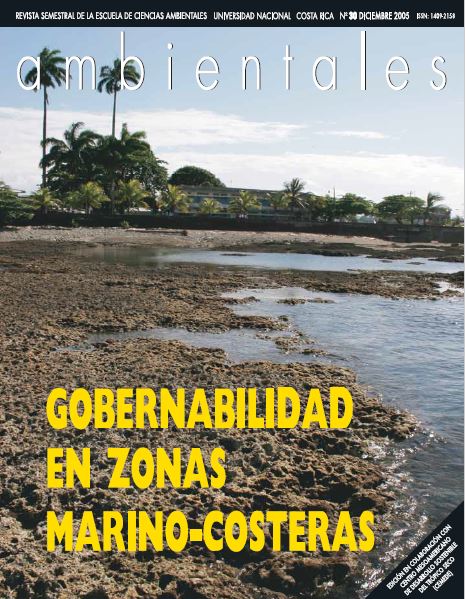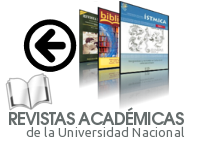Mangroves of the Nicoya Peninsula, Costa Rica
DOI:
https://doi.org/10.15359/rca.30-1.9Keywords:
Manglares, Península de NicoyaAbstract
Mangrove swamp ecosystems are spread along the Costa Rican Pacific Coast from Puerto Soley until the estuary of Coto Colorado River. In the Nicoya Peninsula, the most important area is formed by the mangrove swamps in the Tempisque River estuary system and a sector in the Nicoya Gulf. They extend over a big surface along the riverbanks in the aforementioned estuary, from Bolsón River until the Cabo Blanco estuary, in the border of the inner sector in the gulf. It includes a large portion ranging in width, from a few meters up to six kilometers, like the mangrove swamps in the Letras estuary. The direct and indirect impacts on such waterlogged areas affect in a negative way on this estuarial ecosystem, pollution by agrichemical products is a very important shocking effect presented in a short term. Likewise, the transformation in the land use in inner areas has influence by adding sediments and chemical residues. In addition, the development in the growing tourist activity in the open coastland area in the peninsula, based in a disorderly use in the marine coastal zone, has made some damage too. It must be added to these impacts, the effect in the climatic changes over these areas.
References
Cortés J., A. C. Fonseca y M. Coll. 2000. Descripción del manglar del Refugio Nacional de Vida Silvestre Gandoca-Manzanillo. Limón [impresión doméstica]
Costa Rica: leyes, decretos. 1992. [compilación, selección y actualización de Ricardo Zeledón]. Porvenir. San José.
Cowardin, L. M. et al. 1979. Classification of Wetlands of Deepwater and Habitats of the United States Fish and Wildlife Service. Washington, D.C.
Jiménez, J. A. 1994. Los manglares del Pacífico centroamerica-no. Efuna. Costa Rica.
Jiménez, J. A. “Ambiente, distribución y características estruc-turales de los manglares del Pacífico de Centroamérica: contrastes climáticos”, en Yánez, A. y A. L. Lara (eds.). 1999. Ecosistemas de manglar en América Tropical. Instituto de Ecología de México, UICN/Orma. Costa Rica.
Lacerda, L. D. et al. “Mangrove Ecosystems of Latin America and the Carbbean: A summary”, en L. D. Lacerda (coord.). 1993. Conservation and Sustainable Utilization of Mangove Forest in Latin America and Africa. Mangrove Ecosystems. Internatinal Society for Mangrove Ecosystems.
Madrigal, M. 2000. Amenazas, perturbaciones y beneficios de los manglares de la costa pacífica de Costa Rica. Tesis de Maestría, Universidad Nacional. Costa Rica.
Mendelssohn, I. A. y K. L. Mckee. “Salt marshes and Mangroves”, en M. G. Barbour y W. D. Billings (eds.). 2000. North American Vegetation. Cambridge University Press. New York.
Pizarro, F. y S. Angulo. 1994. Diagnóstico de los manglares de la costa pacífica de Costa Rica. Una-Catie-UICN. Costa Rica. Pizarro, F. et al. 2004. Manual de procedimientos para el mane-jo de los manglares. Efuna. Costa Rica .
Windevoxhel, N. y A. Imbach. 1999. “Uso sostenible de man-glares en América Central”, en Amur, Tania et al. (eds.). 1999. Manejo productivo de manglares en América Central. Catie. Costa Rica.
Downloads
Published
How to Cite
Issue
Section
License

This work is licensed under a Creative Commons Attribution-NonCommercial-ShareAlike 4.0 International License.



















